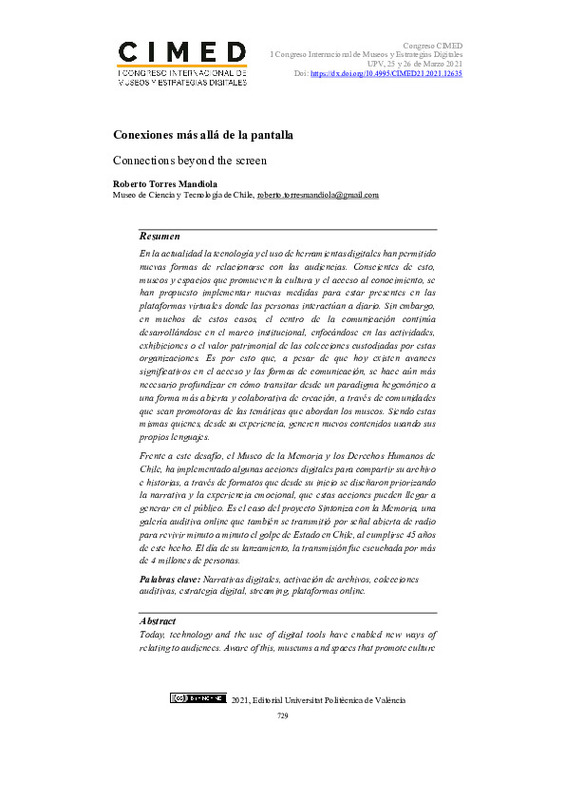|
Resumen:
|
[EN] Today, technology and the use of digital tools have enabled new ways of
relating to audiences. Aware of this, museums and spaces that promote culture and access to knowledge are implementing new ways to be present ...[+]
[EN] Today, technology and the use of digital tools have enabled new ways of
relating to audiences. Aware of this, museums and spaces that promote culture and access to knowledge are implementing new ways to be present in the
virtual platforms where people interact daily. However, in many of these cases,
the center of communication continues to be institutional, focusing on
activities, exhibitions or the heritage value of their collections.
This is why, even though today there are significant advances in access and
the way we communicate, it is more necessary to go deeper into how to move
from a hegemonic paradigm to a more open and collaborative form of
creation, through communities that are promoters of the themes dealt with by
the museums, these being the same who, from their experience, generate new
content using their languages.
Faced with this challenge, the Museum of Memory and Human Rights of Chile
has implemented some digital actions to share part of its collections, in formats
that from the beginning were developed by prioritizing the narrative and
emotional experience that these actions can generate with the public. This is
the case of “The Memory Dial”, an online audio gallery that was transmitted
by open radio signal and that revived the coup d'état in Chile minute by minute
on the 45th anniversary of this event. On the day of its launch, it was heard by
more than 4 million people.
[-]
[ES] En la actualidad la tecnología y el uso de herramientas digitales han permitido nuevas formas de relacionarse con las audiencias. Conscientes de esto, museos y espacios que promueven la cultura y el acceso al conocimiento, ...[+]
[ES] En la actualidad la tecnología y el uso de herramientas digitales han permitido nuevas formas de relacionarse con las audiencias. Conscientes de esto, museos y espacios que promueven la cultura y el acceso al conocimiento, están implementando nuevas medidas para estar presentes en las plataformas virtuales donde las personas interactúan a diario. Sin embargo, en muchos de estos casos, el centro de la comunicación continúa siendo institucional, enfocándose en las actividades, exhibiciones o el valor patrimonial de sus colecciones. Es por esto, que a pesar de que hoy existan avances significativos en el acceso y la forma de comunicarnos, se hace más necesario profundizar en cómo transitar desde un paradigma hegemónico a una forma más abierta y colaborativa de creación, a través de comunidades que sean promotoras de las temáticas que abordan los museos, siendo estas mismas quienes desde su experiencia, generen nuevos contenidos usando sus propios lenguajes. Frente a este desafío, el Museo de la Memoria y los Derechos Humanos de Chile ha implementado algunas acciones digitales para compartir parte de sus colecciones, en formatos que desde su inicio se desarrollaron priorizando la narrativa y la experiencia emocional que estas acciones pueden generar con el público. Es el caso de Sintoniza con la Memoria (www.sintonizaconlamemoria.cl), una galería auditiva online que se transmitió por señal abierta de radio y que revivió minuto a minuto el golpe de Estado en Chile, al cumplirse 45 años de este hecho. El día de su lanzamiento fue escuchada por más de 4 millones de personas.
[-]
|








